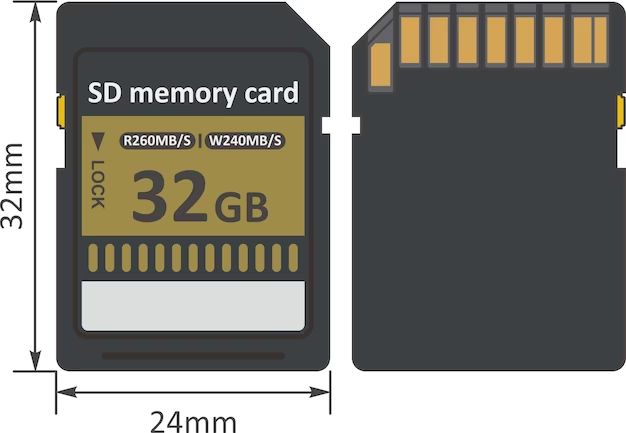SD card stands for Secure Digital card. It is a type of removable flash memory card that is used for storing data in devices like digital cameras, smartphones, camcorders, and many other electronics. The SD card was introduced in 1999 by SanDisk, Panasonic and Toshiba and has since become the most widely used format of memory card.
What does SD stand for?
The SD in SD card stands for Secure Digital. The Secure Digital format was designed to provide a secure way of storing digital information and prevent unauthorized access to data stored on the card. The SD format uses cryptographic security techniques for authentication and protects copyrighted data.
Types of SD cards
There are several types and sizes of SD cards available today. The main ones are:
- SD – The original SD card format with capacities up to 2GB.
- SDHC – SD High Capacity card that supports 4GB to 32GB storage.
- SDXC – SD eXtended Capacity format supporting up to 2TB storage.
- microSD – A smaller form factor SD card used in smartphones and tablets.
SD card sizes
SD cards come in different storage capacities. The capacities typically range from 1GB to 1TB for full size SD cards. MicroSD cards are available from 1GB up to 1TB as well. Higher capacity cards allow you to store more photos, videos, music etc. Some common SD card sizes are:
| SD Card Type | Common Sizes |
|---|---|
| SD | 1GB, 2GB |
| SDHC | 4GB, 8GB, 16GB, 32GB |
| SDXC | 64GB, 128GB, 256GB, 512GB, 1TB |
| MicroSD | 1GB, 2GB, 4GB, 8GB, 16GB, 32GB, 64GB, 128GB, 256GB, 400GB, 512GB, 1TB |
SD card speeds
SD cards have different speed ratings which indicate the minimum guaranteed sustained write speed. Faster SD cards allow quicker transfer of data like high resolution photos and videos. Some common speed classes are:
- Class 2 – Minimum write speed of 2MB/s
- Class 4 – Minimum write speed of 4MB/s
- Class 6 – Minimum write speed of 6MB/s
- Class 10 – Minimum write speed of 10MB/s
- UHS Class 1 – Minimum write speed of 10MB/s
- UHS Class 3 – Minimum write speed of 30MB/s
Higher speed classes allow for faster capture of images and video recording. Top of the line SD cards now offer maximum speeds up to 300MB/s write speeds.
Uses of SD cards
SD cards are used in a wide variety of consumer electronics devices to store data. Some common uses are:
- Digital cameras – For storing photos and videos
- Smartphones – For expanding storage capacity
- Tablets – Again for increasing available storage
- Camcorders – For recording high definition video
- Gaming consoles – Storing games, profiles and other data
- Laptops – Adding more storage capacity
- Drones – Storing aerial photos and footage
- Dash cams – Recording driving footage
- Security cameras – Storing surveillance recordings
SD cards are used in portable devices for primary or additional storage due to their small form factor and high portability. The ability to store large amounts of data like high resolution photos and full HD video make them very popular.
Advantages of SD cards
Here are some of the key advantages of using SD cards for storage:
- Compact size – SD cards are very small in size, especially microSD cards used in phones.
- High capacity – SDXC cards provide up to 1TB of storage space.
- Portability – Small size makes them extremely portable.
- Durability – SD cards are shockproof, waterproof and rugged.
- Compatibility – Supported across countless devices and platforms.
- Affordability – Cost effective price per gigabyte of storage.
- Reusability – SD cards can be erased and reused multiple times.
- Expandable storage – Provide an easy way to expand storage of devices.
Disadvantages of SD cards
Some drawbacks of using SD cards include:
- Less reliable than internal storage of devices
- Small size makes them easy to misplace
- Slower transfer speeds than internal storage
- Vulnerable to data corruption and physical damage
- Not intended for long term archival storage
Difference between SD, microSD and miniSD
The main differences between the three formats are:
- SD – Original size cards that measure 32 x 24 x 2.1 mm
- miniSD – Smaller version at 21.5 x 20 x 1.4 mm
- microSD – Even smaller at 15 x 11 x 1 mm
microSD cards are the smallest and used in smartphones and tablets. SD remains the most popular full size card. miniSD has been discontinued and is rarely used now.
Conclusion
SD cards provide removable, portable flash memory storage for a wide variety of electronics. Their compact size, high capacity, compatibility and affordability has made them a ubiquitous standard for recording and storing digital data. With capacities up to 1TB now available, SD cards continue to evolve to support storage needs across consumer devices and platforms.
